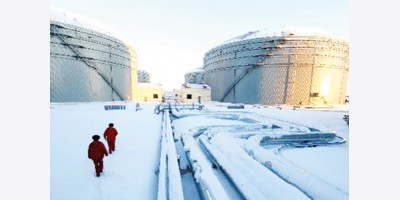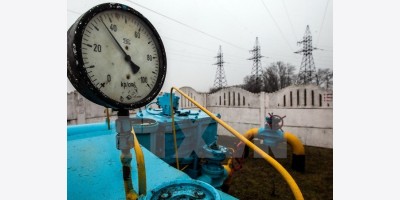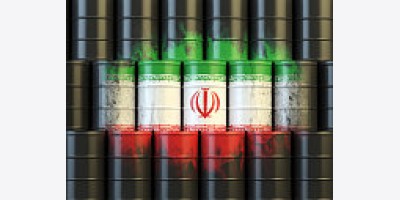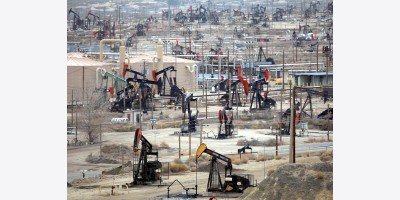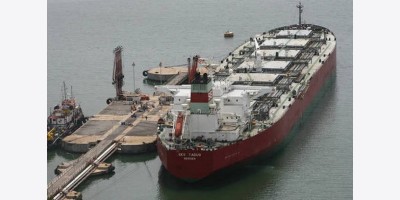The number of countries receiving cargoes of Kurdish crude oil from the ports of Mersin and Dortyol along the Turkish Mediterranean coast has quietly grown over the last few weeks as international focus has remained set on the tankers leaving nearby Ceyhan.
According to market sources and ship-tracking data, small cargoes of Kurdish crude have loaded from Mersin and discharged into Italy, southern France and Israel, while flows from Dortyol have been moving steadily across the Atlantic to the US Gulf Coast.
As the Kurdistan Regional Government flexes its export muscles in direct defiance of Baghdad — which insists that all of Iraq’s crude exports, including those from Kurdistan, must be controlled by Iraqi state marketer SOMO — much of the focus from the international community has been concentrated on the handful of Suezmax cargoes leaving Ceyhan.
However, the smaller cargoes slipping out of Mersin and Dortyol have attracted comparatively little attention from Baghdad, despite the growing controversy over independent Kurdish crude exports.
One crude trader, when asked about a recent shipment from Mersin, labeled it as “not the contested ex-Ceyhan barrels”, drawing a clear distinction between Kurdish crude piped through to Ceyhan and Kurdish oil delivered by truck to the Mediterranean coast.
Trucks of crude have been moving steadily from the Taq Taq, Tawke and Shaikan fields in Kurdish northern Iraq through Turkey to the coast where they have been sold in 40,000 mt clips to a variety of international buyers, largely via open tender.
Anglo-Turkish Genel Energy, which operates several fields in the region, sold the first Taq Taq cargo out of Mersin in April 2013. Exports of heavy Tawke and still heavier Shaikan followed soon after. While the central government has repeatedly objected to the exports, threatening any country caught lifting them with legal action, it has made no move to directly halt flows from Kurdish Iraq to Turkey.
As a result, the number of locations receiving volumes from both smaller Mediterranean ports has grown over the last two months, according to data from Platts vessel-tracking software cFlow.
Cargoes of Kurdish crude have have moved from Mersin to destinations across the Mediterranean, including Trieste in Italy — which serves as an import point for a number of refineries in central Europe.
Shipments have also gone to Israel, the Black Sea and most recently to Fos-sur-Mer in southern France, the delivery point for the SPSE pipeline.
According to traders and to ship-tracking data, the Faneromeni A discharged two cargoes of Kurdish crude at Fos in June. The SPSE pipeline supplies crude from tanks at the port near Marseille to refineries in France and Switzerland.
WAF crudes fall to multi-year lows amid weak demand
West African crude values continued to decline Wednesday amid an oversupply of cargoes that was causing differentials to drop at a steady pace, trading sources said.
Qua Iboe was assessed at Dated Brent plus $1.15/b, lowest since July 30, 2012, Platts data showed. Bonny Light was assessed at Dated Brent plus 95 cents/b, lowest since September 3, 2012.
Angola’s Cabinda was its lowest since January 12, 2011 at Dated Brent minus $1.78/b. Refining margins have been soft in both Europe and Asia on low weak product cracks, and traders said the market would have to weaken further to make WAF grades more competitive — and appealing — to refiners.
“Unfortunately, the WAF market is more a reflection of the market to come. We are still seeing some long-haul crude from Latin America pointing towards Europe,” said a trader. “The weakness rolls forward until we see a pick-up in products cracks which will actually increase demand than just increasing inventories.”
Sources said there were still about 7 million barrels of Nigerian July-loading crudes unsold, with more than half of the August loading program available as well, putting huge pressure on crude values. Sources also said one interesting development in the last few weeks was that refining margins for sour crudes were becoming more attractive than sweet crudes. This meant there was more room for WAF grades to fall, while the Urals market was seeing a slight pickup in values after differentials for the Russian crude were languishing for the past month. “It all looks pretty messy.
Sour margins are looking so much better than sweet even with this fall in WAF differentials,” said a second trader. “I guess with the [HMEL] Indian refinery problems and China still standing off and Libyan crudes continuing to come onto the market, we will stay at these levels or below,” he added.
Sources also said Indian demand for August-loading Nigerian crudes was looking slightly lower, adding to the bearish sentiment. “Indian demand is much weaker for August. State-owned Indian refiners are buying much less and taking cheaper Angolan crudes [instead],” the first trader said.
US crude stocks fell a larger- than-expected 3.2 million barrels last week, as refiners increased run rates and imports declined, data Wednesday from the Energy Information Administration showed. Analysts had been anticipating a 2 million-barrel draw in stocks. Late Tuesday, the American Petroleum Institute reported a much smaller 876,000-barrel draw in crude stocks.
A surge in US refiner utilization rates to 91.4% of capacity last week, up 2.9 percentage points, whittled away at supplies, mainly in the Gulf Coast, where crude stocks fell 3 million barrels to 204.8 million barrels.
Refiners in the USGC increased utilization rates by 4.9 percentage points to 93% of capacity. The rise in total refinery rates was due in part to the return of a large crude unit at Phillips 66’s 58,000 b/d Billings, Montana, refinery that returned to service last week after a fire erupted on June 11, according to a Platts report. Also, ExxonMobil restarted a unit on June 12 at its joint-venture 200,700-b/d refinery in Chalmette, Louisiana. In Texas, ExxonMobil said last week that planned work at its 365,000 b/d refinery in Beaumont had ended and the plant has returned to normal operations.
While US refiners increased rates, imports of crude declined, falling 76,000 b/d to 7.27 million b/d. Crude stocks in the Midwest fell 900,000 barrels to 90.5 million barrels last week, including a 1.3 million-barrel draw at the NYMEX delivery hub at Cushing, Oklahoma. The draw puts stocks at the hub at a 48.5% deficit to the EIA five-year average.
GASOLINE STOCKS DROP ON DEMAND UPTICK
US gasoline stocks fell 1.2 million barrels to 213.7 million barrels last week, outpacing expectations of a 750,000-barrel draw. Analysts were anticipating a rise in gasoline demand ahead of the US holiday weekend.
And indeed, implied demand for the fuel climbed 355,000 b/d to 9.17 million b/d last week. That puts demand on a four-week average at 8.97 million b/d, just slightly above the four-week average from the year prior.
Production of finished gasoline also surged, rising 382,000 b/d to 9.44 million b/d. The rise puts production some 50,000 b/d above year-earlier levels.
NYMEX August crude futures settled 86 cents lower at $104.48/barrel Wednesday, as concerns over Tropical Storm Arthur’s possible impact on East Coast refiners trumped a weekly draw in crude stockpiles.
August crude popped higher, trading up to a session high of $105.53/b after US Energy Information Administration data showed that US crude stocks fell a larger-than-expected 3.2 million barrels last week.
But Carl Larry, president of Oil Outlooks, said concerns that Tropical Storm Arthur will knock out power to East Coast refiners, leading to a dip in demand for crude, capped any gains in futures. “That will send demand for gasoline higher, but if refineries do go down, it will back up crude,” Larry said.
ICE August Brent settled $1.05 lower at $111.24/b. In products, NYMEX August ULSD settled 3.21 cents lower at $2.9461/gal and August RBOB ended 1.26 cents lower at $3.0240/gal.
The National Hurricane Center said Wednesday that a hurricane watch has been issued as far north as North Carolina’s Outer Banks and a tropical storm watch has been extended to the Virginia/North Carolina border as Tropical Storm Arthur strengthens and moves slowly toward Florida’s east-central coast (See story, 1255 GMT).
Larry noted that investors could have also been moving money and risk to equities and treasuries ahead of an expected strong non-farm payrolls data due on Thursday.
The weekly draw in crude stocks was more than the 2 million-barrel draw that analysts had been anticipating. At 384.9 million barrels for the June 27 reporting week, crude stocks were about 4.7% above the EIA five-year average.
The cash markets for Permian Basin-produced crudes plummeted in early trading Wednesday on news that Phillips 66 will preemptively start maintenance at its 146,000 b/d refinery in Borger, Texas.
Phillips 66 is starting the work early after the facility suffered a power outage last week, traders said. West Texas Sour was assessed Tuesday at WTI minus $8.75/b and was heard traded at WTI minus $11.50/b Wednesday morning.
That is the lowest the grades has been since being assessed at WTI minus $12.50/b on February 20. WTI in Midland, Texas, was assessed Tuesday at WTI minus $8.55/b and was heard offered at WTI minus $9.75/b Wednesday morning.
By Anthony DiPaola Jul 3, 2014 5:19 AM GMT+0700
Targeting Iranian crude exports to force cuts in the nation’s nuclear program is becoming a riskier strategy for oil markets as violence erupts in neighboring Iraq and supply disruptions persist in Libya.
Negotiators from the U.S., Russia, China, Germany, France and the U.K. return to talks with Iranian officials in Vienna today to discuss a deal that would lift sanctions on energy, banking, shipping and other areas of trade in return for Iran ensuring its nuclear program is peaceful. Last year, Iran agreed to scale back the program and got limited relief from bans on petrochemicals, gold and auto trade.
The talks are colliding with increased fighting across northern Iraq, the world’s fourth-largest crude exporter, and political feuding in Libya, holder of Africa’s biggest oil reserves, where output has dropped. The six nations will be weighing whether to keep curbs on Iran, which has been allowed to maintain exports at about 1.1 million barrels a day under the temporary pact expiring July 20. The Persian Gulf nation was shipping 2.5 million barrels before sanctions.
Diplomatic Hurdles on Iran's Nuclear Road
“Iranian oil has been helping at this difficult time in markets,” Robin Mills, a Dubai-based analyst at Manaar Energy Consulting & Project Management who previously worked as an engineer on Iran for Royal Dutch Shell Plc, said by phone on June 30. “If you start taking more Iranian oil off the market, it will tighten and you put yourself in the bad situation of having less flexibility.”
Oil tankers off the port of Bandar Abbas, southern Iran.
Biggest Threat
Brent crude traded at about $112 a barrel yesterday and slipped 0.9 percent to end at $111.24 today on the ICE Futures Europe exchange. It rose to $115.71 on June 19, a nine-month high. Options prices are close to the most bullish they’ve been in 10 months and volatility in Brent has climbed from a record low because of the fighting in Iraq.
Forces from the militant group that now calls itself the Islamic State seized towns in northern Iraq and attacked the nation’s biggest oil refinery last month. The fighting poses the single biggest threat to new output this decade within the Organization of Petroleum Exporting Countries, which supplies 40 percent of the world’s oil, according to the International Energy Agency, a Paris-based adviser to 29 nations.
Iran will probably export crude at current levels in the second half of the year, according to a Bloomberg survey of six oil analysts. The talks in Vienna will probably be extended for another six months with no additional oil sanctions imposed on Iran, they said.
Crude Exports
Two U.S. officials who weren’t authorized to be quoted said Iranian crude exports are within the range allowed by the interim deal. Iran’s shipments of crude and condensate last year were about 1.04 million barrels a day, according to customs and IEA data compiled by Bloomberg.
Iraq and Iran are both members of OPEC, which will need to pump the most in two years over the next six months to meet record global demand of 94 million barrels a day in the fourth quarter, the IEA said June 13. It raised its estimate for how much consumers will demand of the group’s oil by 300,000 barrels a day to 30.9 million on average in the second half, almost 1 million more than OPEC’s own target.
“The balance in world oil supplies is much tighter than was expected at the beginning of this year,” Eugen Weinberg, an analyst at Commerzbank AG in Frankfurt, said by phone June 30. “Definitely sanctions are not off the table. But the escalation of the situation in Iraq comes at no good time for such sanctions. We don’t have such spare capacity at the moment to cope with the possible shortfall from Iraq as well.”
Enrichment Capacity
The U.S. and its allies, concerned Iran may develop a nuclear weapon, want it to reduce uranium-enrichment capacity. Iran says its program is for civilian power supply and medical research only.
U.S. Secretary of State John Kerry wrote in a Washington Post editorial yesterday that “substantial gaps still exist between what Iran’s negotiators say they are willing to do and what they must do to achieve a comprehensive agreement.”
The six nations negotiating with Iran are determined to reach a “comprehensive agreement” by July 20, European Union spokesman Michael Mann said in an e-mail June 26. Iran officials hope the talks will result in such an accord, Deputy Foreign Minister Abbas Araghchi told the Tehran-based SNN news agency on June 29.
Risks of supply disruptions elsewhere in the world may not translate into output reductions in practice, Cliff Kupchan, a Washington-based consultant at Eurasia Group who specializes in Iran, said by phone June 26.
Robust Supply
“Supply will remain relatively robust despite the current range of geopolitical crises,” Kupchan said. Libya’s output is likely to recover and there are no immediate risks to shipments from Iraq’s south, home to most of the nation’s production, he said.
Rebels who’ve blocked eastern ports in Libya since last year said today that they are reopening Es Sider and Ras Lanuf in the country’s east.
Political and security issues have also kept Nigerian crude off the market and raised concern that future production may be at risk, the IEA said in its mid-year report published June 17. Conflict in Syria, South Sudan and Yemen will also hurt output this year, the IEA said.
The negotiations in Vienna will focus specifically on Iran’s compliance with commitments to scale back its nuclear program and probably won’t take account of the oil market, said Gary Sick, a senior research scholar at Columbia University’s Middle East Institute.
Background Noise
“You can’t talk about anything in the Persian Gulf without oil coming up,” Sick said by phone June 26. “But I’ve seen no evidence that the negotiators have seen oil as anything other than background.”
Iraq’s oil production has mostly been unaffected by the fighting in the north. The nation will export close to a record 2.8 million barrels a day this month, according to loading programs obtained by Bloomberg.
Still, the threat of widening violence in Iraq spurred speculation that the country’s long-term supply gains won’t be as high as the government’s forecast -- that production will exceed 8 million barrels a day from 2018. By contrast, Iran can pump more oil than it is now. The nation’s output averaged 2.6 million barrels a day last year, the lowest since 1989, according to data compiled by Bloomberg.
“Every additional barrel of oil Iran can sell is good news for them,” said Abhishek Deshpande, a crude markets analyst at Natixis SA in London. This month “we’ll have a better sense of where talks are going and we’re most likely to have an extension to December.”
To contact the reporter on this story: Anthony DiPaola in Dubai at adipaola@bloomberg.net
To contact the editors responsible for this story: Alaric Nightingale at anightingal1@bloomberg.net Dan Stets
By Andrew Willis Jul 3, 2014 4:57 AM GMT+0700
Colombia is looking to extend a decade-long oil expansion by improving Ecopetrol SA (ECOPETL)’s community relations and environmental permitting, as shares at the state-run producer slump to a four-year low.
Ecopetrol is creating regional operational centers run by a vice president with managerial and decision-making powers, Mines and Energy Minister Amylkar Acosta, who sits on Ecopetrol’s board, said. The changes include strengthening the company’s VP office with environmental responsibilities, partially aimed at speeding up permitting, Acosta said.
“The board asked the administration to give this top priority,” he said in a telephone interview today. “Delays are often because companies don’t carry out their tasks.”
Colombia’s oil output has been rising since 2005 as companies such as Ecopetrol and Pacific Rubiales Energy Corp. tap areas once overrun by guerrillas. Now an increase in rebel attacks on infrastructure, community protests and permitting bottlenecks threaten to crimp production.
The Cano Limon-Covenas pipeline restarted operations May 25 after a two-month shutdown caused when the forest-dwelling Uwa group prevented repairs following a rebel attack. The Uwa say the pipeline has polluted their indigenous homeland.
Shares in Ecopetrol fell 0.9 percent to 3,340 pesos in Bogota today, the lowest since August 2010. The stock is down 17 percent in the past year, the only oil producer among 15 global peers tracked by Bloomberg to decline in that period.
Million Target
Colombia produced an average of 1,019,000 barrels a day in the first half of June, with the mines and energy ministry now forecasting 1,007,000 barrels a day on average this year, Acosta said. The finance ministry, which Acosta said is more conservative in its estimates, is targeting 981,000 barrels a day this year from 1,006,000 last year, according to a June 17 report published on its website.
Production fell below one million barrels a day in March, April and May of this year, according to the hydrocarbon agency.
The changes at Ecopetrol don’t include replacing Chief Executive Officer Javier Gutierrez, Acosta said.
To contact the reporter on this story: Andrew Willis in Bogota at awillis21@bloomberg.net
To contact the editors responsible for this story: James Attwood at jattwood3@bloomberg.net Will Wade
By Brian K. Sullivan Jul 3, 2014 4:32 AM GMT+0700
Tropical Storm Arthur grew to near-Category 1 hurricane strength off the coast of Florida, prompting alerts as far north as Virginia.
Arthur was about 220 miles (355 kilometers) south-southeast of Charleston, South Carolina, at 5 p.m. local time with maximum winds of 70 mph, moving north at 7 mph, the National Hurricane Center said. A storm becomes a hurricane when its winds reach 74 mph.
“Arthur is a strong tropical storm right now,” said Paul Walker, a meteorologist with AccuWeather Inc. in State College, Pennsylvania. “The storm will continue to strengthen and should reach hurricane strength maybe by tonight.”
The Atlantic season’s first storm would be the first hurricane to hit the U.S. since 2012 if it reaches that level and strikes North Carolina’s Outer Banks. Its movement up the coast will also stall a cold front out of the western U.S., triggering heavy rains along the Eastern Seaboard.
Officials in Dare County, North Carolina, where at least 250,000 vacationers are spending their Fourth of July holiday, will make a decision later today on whether to call for evacuations.
A countywide state of emergency was declared in neighboring Hyde County, where officials called for a voluntary evacuation of Ocracoke Island. North Carolina Governor Pat McCrory declared states of emergency throughout coastal portions of the state.
Alerts Posted
With winds of at least 74 mph and pounding surf expected in the next 36 hours, a hurricane warning was issued from Surf City to Duck, as well as Pamlico Sound and eastern Albemarle Sound in North Carolina, the center in Miami said.
A hurricane watch is in effect from Little River Inlet to south of Surf City.
Storm surge of as much as 4 feet is possible along the coast of North Carolina and 1 to 3 feet in South Carolina, the center said.
Tropical storm watches and warnings stretch from the Santee River in South Carolina to the Cape Charles Light in Virginia.
Cape Cod in Massachusetts is expected to be struck by tropical storm conditions this weekend as the storm passes, the National Weather Service in Taunton, Massachusetts, said.
“Interests along the United States East Coast north of the warning area, primarily in southeastern New England, should monitor the progress of Tropical Storm Arthur,” the hurricane center said.
To contact the reporter on this story: Brian K. Sullivan in Boston at bsullivan10@bloomberg.net
To contact the editors responsible for this story: David Marino at dmarino4@bloomberg.net Charlotte Porter
By Randall Hackley Jul 3, 2014 12:32 AM GMT+0700
Xylem Inc., a New York-based water-technology specialist, sold its U.K. valves unit to the flow-control company Rotork Plc to focus more on its core products.
The $25 million divestiture of Xylem Flow Control Ltd., whose pneumatic and hydraulic valves are used mostly in the oil and gas industry, equals the sales of the business last year, Xylem said today in a statement. The purchase is “an excellent addition to our instruments division,” Rotork said.
To contact the reporter on this story: Randall Hackley in London at rhackley@bloomberg.net
To contact the editor responsible for this story: Randall Hackley at rhackley@bloomberg.net
Libyan Rebels Say Two Oil Ports Reopened After Blockade
By Maher Chmaytelli Jul 2, 2014 7:16 PM GMT+0700
Libya is now producing about 320,000 barrels a day, or about a fifth of its output... Read More
Rebels who helped decimate Libyan oil production by blockading eastern ports said the nation’s largest and third-largest export facilities can ship crude again, in a gesture of support for the newly elected parliament.
Es Sider and Ras Lanuf, which have combined capacity of 560,000 barrels a day, will reopen today, according to Ali Al-Hasy, a spokesman for the rebels’ Executive Office for Barqa. Libya’s state-run National Oil Corp. hasn’t been informed of the move, said Mohamed Elharari, company spokesman. The two terminals would increase Libya’s crude-export capacity almost five-fold.
The loss of the Libya’s oil production boosted the price of Brent, a benchmark for half the world’s traded crude. Brent futures for August settlement fell as much as 0.7 percent to $111.54 a barrel today, the lowest intraday level in almost three weeks. The restart of operations at the two ports would probably send Brent down to $110 a barrel, Commerzbank AG said.
“The Petroleum Facilities Guards in Es Sider and Ras Lanuf have been instructed to allow the two ports to resume operations,” Al-Hasy said by phone from eastern Libya. “This is an initiative from the Executive Office for Barqa to welcome the newly elected parliament that includes well-known patriots, and to encourage them to fight corruption and protect the natural resources of the nation.”
The self-declared Executive Office for Barqa seeks self-rule for the eastern region of Libya known also as Cyrenaica. It occupied oil ports in the region at the end of July 2013, demanding an oil-revenue-sharing agreement to make up for the neglect the area experienced under Muammar Qaddafi’s 42-year rule.
Brent Falls
Libya is now producing about 320,000 barrels a day, or about a fifth of its output before Qaddafi was overthrown in 2011, according to state-run National Oil Corp. “We will lift the state of force majeure in Es Sider and Ras Lanuf when we receive confirmation of this agreement from the government,” said Elharari. Force majeure is a legal step that protects a company from liability when it can’t fulfill a contract for reasons beyond its control.
The premium of the front-month Brent contract over the second month, a structure called backwardation that signals tight near-term supplies, narrowed to as little as 7 cents a barrel on the ICE Futures Europe exchange in London today, the least since April 15. Brent’s premium to U.S. benchmark West Texas Intermediate narrowed as much as 41 cents to $6.54 a barrel on ICE.
Government representatives including Justice Minister Salah al-Mirghani and a delegation of the Barqa federalists sealed the agreement yesterday in the eastern city of Tobruk, Al-Hasy said. “The facilities in Es Sider and Ras Lanuf are in very good shape, they are ready to operate.”
‘Ready to Operate’
Es Sider has 340,000 barrels in daily loading capacity and Ras Lanuf 220,000 barrels, according to the oil ministry. The nation has a total of nine oil export terminals, of which three -- Brega, Jurf and Bouri -- are operating with a combined daily loading capacity of 145,000 barrels.
While the other terminals -- Zawiya, Mellitah, Hariga and Zueitina -- are under government control, they are not exporting because of protests at the ports or connected oilfields unrelated to those of the Barqa federalists.
The government has agreed to pay “in the next few days” the salaries of Petroleum Facilities Guard who defected to the Barqa group during the blockade and to implement a preliminary agreement reached on April 6, Al-Hasy said. The rebels handed over the oil ports of Hariga and Zueitina after this accord in exchange for amnesty and salary payments for the guards, and an audit of the National Oil Corp.’s oil sales since the overthrow of Qaddafi.
The Barqa federalists in May threatened to re-occupy Hariga and Zueitina in protest over the appointment as prime minister of Ahmed Maiteg, whom they see as allied with the nation’s Islamists. His appointment was later withdrawn, and elections were held last week for a new parliament.
To contact the reporter on this story: Maher Chmaytelli in Dubai at mchmaytelli@bloomberg.net
To contact the editors responsible for this story: Alaric Nightingale at anightingal1@bloomberg.net James Herron, Rachel Graham
By Rakteem Katakey Jul 2, 2014 1:08 PM GMT+0700
Exxon Mobil Corp. (XOM), the world’s biggest energy company by market value, will invest $1 billion to increase diesel production at its Antwerp refinery .
The company will add a delayed coker unit at the 320,000 barrel-a-day refinery in Belgium that will convert high-sulfur oil to diesel for use in trucks and ships, the Irving, Texas-based company said in a statement today. Exxon has spent $2 billion in the past decade on expansions in the refinery including a 130 megawatt power plant and hydrotreater unit that reduces sulfur from fuels, the company said.
“The investment addresses an industry shortfall in capability to convert fuel oil to products such as diesel,” Exxon said in the statement. The expansion “is the first of several being evaluated to further strengthen strategic refineries in Europe to more successfully face the challenging industry environment.”
Exxon’s announcement comes after Total SA (FP), the biggest refiner in western Europe, reported a 10 percent decline in profit in the quarter ended March 31 on smaller crude-processing margins caused by overcapacity. European refinery margins shrank to $6.60 per metric ton of crude processed in the three months from $26.90 a year earlier, Total said in April, citing its European Refining Margin Indicator.
Exxon’s shares have increased 0.2 percent this year, compared with the 6.8 percent gain in the S&P 500 Index (SPX) and a 2.3 percent advance in the Dow Jones Industrial Average. The stock gained 0.7 percent to $101.36 in New York yesterday.
To contact the reporter on this story: Rakteem Katakey in New Delhi at rkatakey@bloomberg.net
To contact the editors responsible for this story: Jason Rogers at jrogers73@bloomberg.net Abhay Singh, Indranil Ghosh
By Brian K. Sullivan and Lynn Doan Jul 2, 2014 8:07 AM GMT+0700
Tropical Storm Arthur strengthened and will probably grow into a hurricane in the next two days threatening North Carolina’s Outer Banks, where at least 250,000 tourists are visiting for the Fourth of July holiday.
The storm was 90 miles (145 kilometers) east-southeast of Cape Canaveral, Florida, with maximum winds of 50 miles per hour, the Miami-based National Hurricane Center said in an advisory at 8 p.m. local time. Tropical storm watches were posted earlier today for Florida’s eastern coast from Fort Pierce to Flagler Beach and additional warnings may be needed as far north as Virginia.
“Strengthening is forecast during the next 48 hours and Arthur is expected to become a hurricane by Thursday,” the NHC said in the advisory.
Arthur is the first named system of the 2014 Atlantic hurricane season, which runs from June 1 through Nov. 30. Its winds are expected to peak at 90 mph, making it a Category 1 storm on the five-step Saffir-Simpson hurricane scale, in the next three days, the center said.
The system will probably pass over or near Dare County, in easternmost North Carolina, early on July 4. Officials met today to discuss what action to take and decided to regroup tomorrow because the forecast remains “uncertain,” a notice on the county website shows.
Moving People
“If evacuation is required, that would occur on Thursday,” Bobby Outten, Dare County’s manager, said by phone. “We’re in the throes of our season, we’ve got about 250,000 to 300,000 visitors down here at this time of year.”
The Outer Banks have more than a 70 percent chance of being struck by winds of at least 39 mph as the storm approaches, according to the center.
Outten said he doubted a countywide evacuation would be needed. The region is well equipped to move people in and out, he said.
“We evacuate every Saturday,” Outten said. “All our visitors leave in the morning and new ones come in on Saturday afternoon. This would be much the same thing, if we are required to do that.”
One to 3 inches (2.5 to 8 centimeters) of rain are expected to fall across central Florida, while parts of the Bahamas may get as much as 6 inches before the system tracks north, the hurricane center said.
Tropical storm-strength winds have been reported in the Bahamas and are expected to strike central Florida later, the center said.
Protecting Grid
Florida Power & Light, the state’s largest utility and a unit of NextEra Energy Inc. (NEE), has spent $1.5 billion to strengthen its grid against storms since two hurricanes struck in 2004, Bill
Orlove, a spokesman, said in a phone interview. Hurricanes Charley and Frances combined that year to cause $15 billion in damage in the U.S., mostly in Florida, according to the National Oceanic and Atmospheric Administration.
After Arthur passes the Outer Banks, it will move northeast during the day on July 4, blocking a cold front coming across the U.S. That means Boston should receive some heavy rain, said Rob Carolan, the owner of Hometown Forecast Services Inc. in Nashua, New Hampshire.
In New York, showers and thunderstorms are expected to develop late tomorrow and into July 3, a combination of the cold front slowly approaching and tropical moisture streaming in from Arthur. New York has a 50 percent chance of rain on July 4, Joe Pollina, a weather service meteorologist based in Upton, New York, said by phone today.
“It would mainly be from the cold front,” he said. “Arthur is going to be somewhere in the southeast or Mid-Atlantic region by then, well to our south.”
In the Pacific, the hurricane center is also monitoring Tropical Storm Douglas, which isn’t a threat to land, and Tropical Storm Elida, which is bringing heavy rains and high surf to western Mexico.
To contact the reporters on this story: Brian K. Sullivan in Boston at bsullivan10@bloomberg.net; Lynn Doan in San Francisco at ldoan6@bloomberg.net
To contact the editors responsible for this story: David Marino at dmarino4@bloomberg.net Yee Kai Pin, Ramsey Al-Rikabi
Bogota, Colombia (Platts)--2Jul2014/430 pm EDT/2030 GMT
Declining oil production caused by terror attacks, community protests and a drop in foreign investment has the Colombian government concerned it will miss its 2014 fiscal goals, according to analysts.
Top industry and government officials have met over the last two weeks in the presidential palace to discuss solutions to an alarming drop in barrels produced so far this year that has been only partially mediated by a recent rise in oil prices, sources said.
Also of concern to the industry and government is the decline in direct foreign investment in Colombian energy projects this year, according to the central bank. The slowdown is a continuation of a trend seen last year when foreign investment in oil and gas totaled $4.9 billion, off 10% from the previous year, according to the Colombian Petroleum Association.
According to exploration indicators, 2014 is shaping up as a disappointing year at a time when the country has made expanding its crude reserves a national priority. A recent CPA report said only 26% of the projected 51,657 square km of seismic exploration studies had been carried out as of May 21. Of the 233 exploratory wells projected to be drilled in 2014, only 60 had been drilled as of that date.
Colombia's crude production in May averaged 950,000 b/d, a 6.3% decline from the same month in 2013. For the year to date, the country's average output is running at more than 100,000 b/d under the 1,095,000 b/d target for 2014 set by the finance and planning ministries last year.
Gone are the days when Colombia's oil output was increasing by annual double-digit percentage gains, with growth driven mostly by the spike in heavy oil production in the eastern Llanos region in fields operated by state-controlled Ecopetrol, Pacific Rubiales Energy and Gran Tierra Energy.
PIPELINE CLOSURE HIGHLIGHTS CHALLENGING SECURITY ENVIRONMENT
Much of this year's drop-off is due to the 93-day shutdown of the 900-km Cano Limon pipeline, which has a peak capacity of 220,000 b/d. Bombed at least 20 times this year by rebels, the pipeline reopened May 25 -- but not before Colombia lost more than 5 million barrels of oil sales, according to Orlando Hernandez, president of Agora Consultorias, a Bogota-based risk analysis firm.
Colombia's challenging security environment was highlighted by the bomb attack by suspected guerrillas Tuesday on state-controlled Ecopetrol's critical oil pumping station at Banadia in eastern Arauca province. No injuries or damage to oil pipelines or other infrastructure was reported.
The attack in Banadia was especially troublesome because it is the point where the 110,000 b/d Bicentennial Pipeline, completed last year, joins with the Cano Limon line, Hernandez said.
On Sunday, suspected guerrillas struck again, launching cylinder bombs inside the Cano Limon oil field operated by Occidental Petroleum, also in eastern Arauca province, injuring 13 people. While rebels routinely bomb the pipeline connecting the Cano Limon field with the Covenas offloading port on the Caribbean, the bombing inside the security walls of the heavily guarded installation was a rare event.
Although President Juan Manuel Santos won re-election on June 15 after running a campaign touting his peace initiative with FARC rebels now being negotiated in Havana, rebel control in certain rural communities where oil companies are exploring and producing has been made evident by recent attacks.
Over the first six months of 2014, attacks by rebels and criminal bands on oil infrastructure in Colombia totaled 64 bombings, down 44% from the 113 attacks over the same period in 2013, according to a study released Wednesday by Hernandez's Agora Consultorias.
But Hernandez said attacks have picked up in recent weeks and noted that the effect of the bombings has never been more negative.
"Despite the reduced number, the [negative] impact has been the most significant in history," Hernandez said, pointing to the impact of Cano Limon pipeline's shutdown. The lengthy Cano Limon closure was also extended by an indigenous community's refusal to allow repair crews on its reservation to restart the line until certain conditions were met.
For many oil executives here, including Chris Spaulding, who heads Talisman Energy's Colombia operation, the rising number of community blockades of oil installations is of more concern than rebel bombings.
Communities increasingly block access to oil fields in rural areas, particularly in the eastern Llanos region, to demand a higher share of oil royalties, more inclusive local hiring or a reduction in environmental damage or truck traffic over rural roads.
Oil companies have also been put off by extended delays in the permitting process for exploratory wells, Spaulding and others have said, although the government insists the permitting process is slowly improving.
OIL, GAS EXPORTS ARE CRITICAL TO ECONOMY
Officials of the mining and energy, finance and national planning ministries first met June 25 to discuss the impacts of the production slowdown as well as measures that might be taken to enable the oil and gas industry to recapture its former dynamism.
The importance of oil and gas sales to Colombia's economic well-being was reflected by last year's export sales of Colombian crude, natural gas and products that ballooned to $32.5 billion, nearly 10 times the $3.38 billion Colombia collected in 2003. Petroleum sales last year accounted for 56% of all export dollars, up from just 26% of the total in 2003.
Some oil executives have said on condition of anonymity that the government should take a harder line with communities that block access to oil fields, noting that the Colombian constitution gives ownership of all natural resources to the state.
Others favor a frequently mentioned but still hypothetical "omnibus agreement" that would cover hiring, permitting, truck traffic and environmental standards and which the government, labor unions, local communities and oil companies theoretically would sign off on.
In addition to a possible short-term fiscal crunch resulting from declining production and investment, the government is also facing a longer-term challenge of boosting reserves. The total proven reserves as of December 31 of 2.445 billion barrels represents only a 6.6-year inventory at current production levels.
Although the Colombian oil boom is nearly a decade old and has seen billions invested in exploration, the country has yet to record a major new oil strike of 1 billion barrels or more to compare with the development of Oxy's Cano Limon field in the 1980s or BP's Cusiana-Cupiagua complex of fields in the 1990s.
--Chris Kraul, newsdesk@platts.com
--Edited by Jason Lindquist, jason.lindquist@platts.com
Houston (Platts)--2Jul2014/1138 am EDT/1538 GMT
US Midwest gasoline stocks rose 434,000 barrels to 48.2 million barrels in the week ending June 27, but were 6.4 million barrels below stocks at the same time last year, Energy Information Agency data showed Wednesday.
A build in blending stocks besides RBOB and CBOB compensated for draws on RBOB and CBOB, EIA data showed.
Regional refinery utilization rose by 2.8 percentage points to 96.1% and held above the 2014 year-to-date average in the Midwest, 92.2%, EIA data showed.
Crude runs rose by 107,000 b/d to 3.659 million b/d. Regional finished gasoline production rose 55,000 b/d to 2.775 million b/d.
--Faiza Hassan, Faiza.hassan@platts.com
--Edited by Derek Sands, derek.sands@platts.com
Dhaka (Platts)--2Jul2014/853 am EDT/1253 GMT
State-owned Bangladesh Petroleum Corp plans to import around 1.58 million mt of oil products from eight term suppliers during the second half of 2014, down 31.30% from the first half, a senior BPC official told Platts Tuesday.
BPC completed term negotiations with eight Asian companies last week, he said.
The drastic fall in imports of 180 CST high sulfur fuel oil with up to 3% sulfur and 0.25% sulfur gasoil are behind the overall decline in the second half, the official said.
BPC will import 380,000 mt of HSFO in the second half, down 27% from the first half, as some privately owned power plants will import HSFO separately on their own to run their oil-fired power plants.
It will import 1.01 million mt of gasoil during H2, down 33.11% from H1 imports, as demand falls during the winter season.
Of the total for H2 2014, BPC will import 1.01 million mt of gasoil, 380,000 mt of HSFO, 170,000 mt of jet A-1, 9,000 mt of 95 RON gasoline and 5,000 mt of superior kerosene.
Kuwait Petroleum Corp. will supply 450,000 mt of 0.25% sulfur gasoil and 120,000 mt of jet A-1 during H2 2014; Petco, the trading arm of Malaysia's Petronas, will supply 200,000 mt of 0.25% sulfur gasoil, 80,000 mt of HSFO, 50,000 mt of jet A-1 and 5,000 mt of superior kerosene.
Emirates National Oil Company will supply 90,000 mt of 0.25% sulfur gasoil and 100,000 mt of HSFO; and PetroChina will supply 90,000 mt of 0.25% sulfur gasoil and 40,000 mt of HSFO.
Vietnam's Petrolimex will supply 30,000 mt of 0.25% sulfur gasoil and 80,000 mt of HSFO and Indonesia's Bumi Siak Pusako 40,000 mt of HSFO during H2 2014.
BPC will import 60,000 mt of 0.25% sulfur gasoil and 20,000 mt of HSFO from China's Unipec, while Philippines' PNOC will supply 96,000 mt of 0.25% sulfur gasoil, 20,000 mt of HSFO and 9,000 mt of 95 RON gasoline, the BPC official said.
The 0.25% sulfur gasoil was concluded at a premium of $4.80/barrel to Mean of Platts Arab Gulf Gasoil assessments for July-December 2014, stable from January-June 2014 and July-December 2013, and up from a premium of $4.30/b in H1 2013, the official said.
The premium for HSFO imports was fixed at $34/mt to MOPAG assessments for 180 CST HSFO, down $1/mt or 2.85% from the January-June 2014 level.
The premium for jet A-1 was set at $5.80/b to MOPAG kerosene/jet assessments for July-December 2014, unchanged from January-June 2014 and July-December 2013. It was higher than the premium of $5.30/b for H1 2013.
For superior kerosene, the premium was fixed at $5.80/b to MOPAG assessments for kerosene/jet, unchanged from levels for January-June 2014 and July-December 2013, and up from $5.30/b in H1 2013.
For 95 RON gasoline, the premium was concluded at $7.50/b to MOPAG assessments for 95 RON gasoline, stable from January-June 2014.
Following the conclusion of the term volumes and prices for H2 2014, BPC will send the outcome of the negotiations to the country's cabinet committee for approval, the BPC official said.
The cabinet committee usually endorses all of BPC's negotiations to import oil products, considering its urgency to meet domestic demand.
Separately, BPC also expects to import around 700,000 mt of crude oil from Saudi Aramco and Abu Dhabi National Oil Company during H2 2014, the BPC official said.
--Mohammad Azizur Rahman, newsdesk@platts.com
--Edited by Jonathan Fox, jonathan.fox@platts.com
London (Platts)--2Jul2014/718 am EDT/1118 GMT
Prices of Russian domestic crude for July loading and delivery firmed compared with June due to higher Brent futures, trading sources said Wednesday.
Western Siberian barrels traded between Rb14,800-14,900/mt on average ($432.7-435.6/mt), compared to Rb14,000-14,300/mt for the previous month.
Surging international crude futures, especially at the start of trading for July barrels, was deemed by some as the main factor underpinning the higher prices.
Brent futures were trading at around $114/b at the start of the July Russian domestic trading window, compared to $111/barrel last month.
Rosneft, whose monthly tender sets the tone for the subsequent spot trading of domestic barrels, awarded its tender for Udmurtia crude at Rb15,195-15,270/mt, or around Rb700/mt up from the Rb14,530-14,600/mt prices it achieved for June loading and delivery crude.
Subsequently spot barrels of Western Siberian crude traded around Rb14,900-15,000/mt. But as trading progressed, Brent futures retreated to levels in the $112's/b and towards the end of the trading window some Western Siberian crude was heard changing hands around Rb14,600/mt.
But the bulk of traded barrels had already changed hands at higher numbers and some traders dismissed the impact of Brent, as its values dropped after trading had actually started. "It is an additional factor, which people consider before trading starts," said a trader.
In July, Russia's crude export duty was only marginally increased from $385/mt to $385.20/mt and had no impact on spot prices, sources said.
The higher export duty pushes down the export netback, which is used as a gauge by domestic traders for the price of domestic crude.
Healthy volumes of Usa crude from the Timan-Pechora region traded on the floor of the St. Petersburg Exchange around Rb14,700-14,800/mt, up from Rb14,150-14,160/mt last month.
Domestic demand has not been affected much by the recent fire at Rosneft's Achinsk refinery, which took it offline, and the expected surplus of crude had not materialized as exports ramped up instead, traders said.
--Elza Turner, elza.turner@platts.com
--Edited by Jeremy Lovell,
Singapore (Platts)--2Jul2014/652 am EDT/1052 GMT
India imported 403,000 b/d of Venezuelan crude in 2013, up 10.1% from 2012, while China imported 293,000 b/d, up 8.9% year on year, according to state-owned Petroleos de Venezuela, known as PDVSA.
India did not import any refined products from Venezuela in 2013, according to PDVSA's recently published annual operational report, compared with 1,000 b/d in 2012.
India overtook China as the largest Asian buyer of Venezuelan crude in 2012, and the trend accelerated last year with the September 2012 signing of a 15-year, 300,000-400,000 b/d oil export deal between PDVSA and independent Indian energy group Reliance Industries Ltd.
Another factor was the completion in mid-2013 of Essar Oil's upgrade to its 405,000 b/d Vadinar refinery, allowing it to process more heavy crude.
While China's Venezuelan crude imports in 2013 rose 8.9%, its imports of refined products -- mainly fuel oil -- fell 8.3% year on year to 77,000 b/d, taking China's overall oil imports from Venezuela to 369,000 b/d, up 4.5% from 2012, according to the PDVSA data.
China and Venezuela have signed a raft of bilateral loan-for-oil deals since 2011. According to PDVSA's consolidated financial statement for 2013, the loan-for-oil deals granted China the right to lift up to 550,000 b/d of Venezuelan crude and products in 2013, up from 530,000 b/d in 2012.
However, China actually lifted 485,000 b/d of Venezuelan oil and products last year, up from 451,000 b/d in 2012, the report said. SINGAPORE'S ENTREPOT ROLE
Most of the discrepancy in the quantity of Venezuelan crude and products reportedly lifted by China (485,000 b/d) and the quantity officially imported by China (369,000 b/d) was accounted for by the role of Singapore as a regional storage and bunkering hub, trading sources said Wednesday.
PDVSA's exports of refined products to Singapore rose 21% year on year to 196,000 b/d in 2013, according to the report. A large percentage of those barrels, also predominantly fuel oil, eventually ended up in China, according to the Singapore market sources.
Elsewhere in Asia, Venezuela's exports of crude oil to Japan quadrupled from a low base to 12,000 b/d, according the PDVSA document, while PDVSA's crude exports to Malaysia fell to 18,000 b/d last year, from 20,000 b/d in 2012.
In the Asia data, PDVSA included Turkey, which imported 15,000 b/d products from Venezuela last year, down from 19,000 in 2012.
Overall, PDVSA said it exported 726,000 b/d of crude and 289,000 b/d of products to Asia in 2013, or a total of 1.015 million b/d, up 9.8% from 2012.
PDVSA's global crude exports dropped 6.1% to 1.935 million b/d in 2013, while products exports fell 3.5% to 490,000 b/d, according to PDVSA President Rafael Ramirez, who presented the report in Caracas Friday.
Ramirez, who doubles as Venezuela's oil minister, told politicians and business leaders that 2013 had been Venezuela's "most difficult year."
The 2013 annual report also said PDVSA's six domestic refineries processed 952,000 b/d in 2013. About 31% of the refineries' output was gasoline and naphtha, 30% was jet and other distillates, 27% residuals, 11% other products and lubricants and 1% asphalt.
PDVSA produced 2.9 million b/d of crude last year, the report said. However, many independent analysts question the reliability of the state-owned group's figures.
--James Bourne, james.bourne@platts.com
--Edited by Meghan Gordon,
Knoxville, Tennessee (Platts)--2Jul2014/450 pm EDT/2050 GMT
The NYMEX August natural gas futures contract settled 9.8 cents lower at $4.357/MMBtu Wednesday as the market looked to another strong storage injection and milder weather forecasts for much of the US into mid-July. "Natural gas futures are heading lower today in response to long-range cooler weather forecasts," said Aaron Calder, senior market analyst at Gelber & Associates. "Surging production, which was expected, and extremely mild weather, which was not, is pushing the contract near its floor."
While near-term weather is expected to be hot and muggy in much of the country, WSI in its 11- to 15-day forecast expects above-average heat to be mostly confined to the West. "We do not favor any prolonged heat events across the central-eastern US," the private forecaster noted.
In addition, most analysts that Platts polled are expecting the US Energy Information Administration Thursday to report a storage injection in the 99-103 Bcf range for the week ended Friday -- well above both the 76 Bcf reported a year ago and the 68 Bcf five-year average. Such a build could mark the eighth triple-digit injection in a row, analysts noted.
"We're turning more bearish on this market," said Elaine Levin, president of brokerage PowerHouse. "Historically, the hottest day of the year happens in the next couple of weeks, and looking at the [weather] maps we're seeing some hot weather, but once again it will only be for a day or two. We just can't sustain it."
With storage "coming up at a pretty good clip and a lack of any sustained weather, it's making the bears happy," Levin added.
"Natural gas is seemingly in extra time -- on the ropes and defensively (fundamentally and technically) weak -- although summer's just begun," said independent analyst Jay Levine of Enerjay.
But "I remain confident ... that the downside in natural [gas] is limited and confident that there will be a series of days when summer heat will ignite another rally in natural [gas] before long," Levine said. "It might not happen today ... and it might not happen tomorrow, but it's gonna happen one of these days."
"Of course, I also thought that the US was going to win yesterday," Levine added.
The August contract traded Wednesday between $4.338/MMBtu and $4.459/MMBtu.
The NYMEX settlement is considered preliminary and subject to change until a final settlement price is posted at 7 pm EDT (2300 GMT).
--Stephanie Seay, stephanie.seay@platts.com
--Edited by Valarie Jackson, valarie.jackson@platts.com
London (Platts)--2Jul2014/954 am EDT/1354 GMT
Dutch and German spot gas prices were trading lower Wednesday on robust system fundamentals, despite ongoing Norwegian field maintenance.
Before midday, the TTF day-ahead last dealt 32.5 euro cents down from Tuesday's close at Eur16.375/MWh, while the corresponding German GASPOOL and NetConnect contracts were 30 euro cents and 20 euro cents lower day on day, respectively, at Eur16.25/MWh and Eur16.65/MWh.
Supply-demand balances remained robust amid continued Norwegian offshore maintenance, with TSO Gassco indicating an aggregate impact of 46 million cubic meters/day.
Norwegian gas exports to Germany are nominated unchanged Wednesday at 58 million cu m, while the Netherlands is receiving 48 million cu m, compared with 43 million cu m Tuesday.
Meanwhile, the Nord Stream pipeline linking Russia and Germany was flowing at around half normal rates, as its operator continued maintenance work due to end Friday.
Nord Stream is nominated to deliver 51 million cu m to Germany Wednesday.
Total Russian flows into Europe are nominated at 244 million cu m, a fall from Tuesday's 267 million cu m.
On the curve, August contracts were also lower in the main continental European markets.
Before midday, August TTF last traded 25 euro cents down at Eur16.65/MWh, while GASPOOL and NetConnect front-month contracts were 27.5 euro cents and 25 euro cents lower, respectively, at Eur16.525/MWh and Eur16.85/MWh.
The August PEG Nord contract last traded before midday at Eur17.40/MWh, a day-on-day fall of 20 euro cents.
Jakarta (Platts)--2Jul2014/828 am EDT/1228 GMT
Indonesia's state-owned Pertamina has signed a second LNG sales and purchase agreement with US-based Cheniere Energy as it tries to secure volumes to meet an impending gas shortage.
In a statement released Wednesday, Pertamina said that it will buy 760,000 mt/year from Cheniere's Corpus Christi LNG plant for 20 years starting 2019.
This adds to the 760,000 mt/year that Pertamina has already committed to buy from Cheniere for 20 years starting 2018 -- the SPA for which was signed in December last year -- taking its total LNG imports from Corpus Christi to 1.52 million mt/year, Pertamina said Wednesday. The company had previously said the first LNG deal was for 800,000 mt/year for 20 years. The reason for the discrepancy in volumes was not immediately clear. "The [latest] agreement is consistent with Pertamina's strategy to [keep pace with] Indonesia's [growing] gas demand," Pertamina's gas director, Hari Karyuliarto, said in the statement.
Under the agreement, Pertamina will buy the LNG on a free on board basis for a purchase price indexed to the monthly Henry Hub price plus a fixed component, the company said, adding that Pertamina will use its own vessels to ship the LNG.
Indonesia is projected to be short on gas from 2019 when demand -- for domestic use and LNG exports -- is forecast by the energy ministry to reach 9.66 Bcf/d compared with supply of 9.35 Bcf/d, and the country will need to boost LNG imports to supplement domestic supply.
According to Salis S. Aprilian, senior vice president at Pertamina's Gas Directorate, Indonesia is targeting to secure LNG supplies of 3 million mt/year from 2020 in order to be able to meet its domestic demand while maintaining its LNG export commitments.
Most of the demand growth is going to come from the power and industrial sectors as they switch from other fuels to gas, Aprilian told Platts in an interview in May.
Indonesia, traditionally an LNG exporter, launched a drive to build floating storage regasification units a few years ago, mainly to facilitate gas delivery to the demand centers, which are located mostly on the islands of Java and Sumatra, from supply sources offshore Kalimantan and Papua, in the absence of a pipeline network.
The country's first FSRU -- a 3 million mt/year facility in West Java -- jointly owned by Pertamina and state-owned gas utility Perusahaan Gas Negara started up in May 2012.
Pertamina is also in the process of converting its Arun liquefaction plant in Aceh, North Sumatra, into a regasification facility. This facility, with a capacity of 3 million mt/year, is scheduled to start up in 2015.
The company is also conducting feasibility studies to build three more FSRUs which, if constructed, could increase the country's LNG import capacity by another 5 million mt/year.
Indonesia does not import any LNG currently and the West Java FSRU is regasifying LNG from the BP-led Tangguh project located on the eastern Papua island.
--Anita Nugraha, newsdesk@platts.com
--Mriganka Jaipuriyar, mriganka.jaipuriyar@platts.com
--Edited by Deepa Vijiyasingam,
By Martin Tillier | Wed, 02 July 2014 21:35 | 0
Benefit From the Latest Energy Trends and Investment Opportunities before the mainstream media and investing public are aware they even exist. The Free Oilprice.com Energy Intelligence Report gives you this and much more. Click here to find out more.
Unless you’ve been living under a rock, you’ve no doubt heard that the U.S. is in the middle of an oil boom. Advances in technology have enabled the recovery of oil and gas from shale formations that were previously impossible to drill effectively or economically, and have led to a surge in the production of both commodities. This is generally presented as a good thing, for sound reasons. As every pessimist will tell you, however, in front of every silver lining is a great big black cloud.
The upside to the shale oil boom is well known. Increased production means lower prices, and lower energy prices translate to a better economy, from which everyone benefits. In addition, anything that leads America closer to self-sufficiency in energy is a plus for the country. Reliance on a still factionalized and unstable Middle East is not a good position to be in.
While this is all true, there are downsides, namely, its environmental impact, storage and transport problems, and economic distortion.
Hydraulic fracturing or “fracking”, the technique being used to unlock the Earth’s riches, is not new. It has been around since 1908 and has been used in oil and gas wells since 1949, but its massive expansion has raised many concerns.
In 2004, the EPA concluded that “injection of hydraulic fracturing fluids into coal bed methane wells poses little or no threat” to drinking water supplies and “does not justify additional study at this time.” But the study was done at a time when fracking was rare, and researchers also found that fracking fluids were toxic and some residue was left behind in bedrock after fracking operations.
In 2004, that small residue was no cause for alarm, but now that there are around 1.1 million wells using hydraulic fracturing in the U.S. according to this report, so the situation has changed. The EPA has conducted new studies and the results are expected later this year.
The possibility that fracking is polluting out drinking water is not the only risk we’re taking. There is evidence that earthquakes have been caused by the earth-fracturing process. So far, they have not been destructive, but again, fracking on the current scale is a new thing and we cannot be sure that that will be the case in the future.
To some extent, the problems that come with the storage and transportation of the huge amounts of oil being produced are also environmental. There is always the risk of spills from pipelines. According to this Guardian report, around 300 pipeline spills have gone unreported in North Dakota alone in the last two years. This and other concerns have led to the U.S. moving most of the newly extracted oil by rail, but this causes its own problems.
The huge volume being transported means that many older tanker cars are being used, often with disastrous consequences. This Politico article highlights the fact that exploding train cars have become a massive danger. As of June, the total damage done by oil train accidents in 2014 was already around twice that done in the previous four years combined.
Economic distortion is another downside, but one that’s hard for most people to get their head around. The economic benefits of the boom are immediate and obvious: cheaper oil and gas than would otherwise have been the case and, according to a 2012 IHS Global Insight report, the creation or support of 1.7 million jobs.
The long-term effects are less obvious, but may have more impact.
The resources being exploited are, by definition, finite, and the boom reduces the incentive to research and invest in alternatives that will be needed at some point in the future. Even in the boom areas, the economic effects of massive drilling are not clear-cut. Skyrocketing land and real estate prices are great for some, but leave others priced out of their hometowns.
In the longer term, it should be recognized that investment dollars are also finite. The diversion of resources to the oil and gas industries will leave other areas short of investment, a fact that will become all too obvious when the wells run dry. In fact, they don’t even have to run dry. A serious drop in the price of oil would make many wells economically unfeasible and the boom could vanish as quickly as it appeared.
On balance, the short-term economic benefits of the fracking boom are probably a good thing, but to ignore the downsides would be foolish. The fracking debate has two sharply divided sides, but, as with most things in life, there is a middle ground.
We can and should be grateful for the benefits of the oil boom, but we should also be aware of the risks, and even begin to devote some of the enormous money being made to efforts that will mitigate those risks, where possible.
By Martin Tillier of Oilprice.com
By Nick Cunningham | Wed, 02 July 2014 21:27 | 0
Benefit From the Latest Energy Trends and Investment Opportunities before the mainstream media and investing public are aware they even exist. The Free Oilprice.com Energy Intelligence Report gives you this and much more. Click here to find out more.
Offshore wind has struggled to get started in the United States, but the federal government just announced a plan that could accelerate its development. The U.S. Interior Department announced July 2 that it plans to auction off 80,000 acres off the coast of Maryland for wind development.
In a statement, Maryland Governor Martin O'Malley hailed the decision, saying, “To combat climate change, we must develop cleaner, renewable sources of energy -- and today's announcement is a tremendous step forward for the U.S. offshore wind industry.”
Unlike the onshore wind industry, offshore wind is still in its early stages. Land-based wind farms are already competing with conventional sources of electricity in certain locations. By 2019, an average onshore wind project will cost around $80 per megawatthour (MWh), compared to a new conventional coal plant at $95/MWh, and a conventional natural gas plant at $66/MWh, according to estimates from the U.S. Energy Information Administration.
On the other hand, offshore wind is expected to cost two and half times that, or approximately $200 per megawatthour.
But offshore wind farms do have advantages over land-based wind power facilities -- such as more powerful and consistent wind speeds, and vast, empty territories in which to operate.
The United Kingdom is the global leader for offshore wind, with 3,689 megawatts already installed – more than the rest of the world combined. Statoil, a major Norwegian oil company, just announced plans to build another 402 megawatts of offshore wind on Britain’s eastern coast in the North Sea.
In the U.S. though, offshore wind has been slow to catch on. Cape Wind, a proposed offshore wind project to be constructed near Martha’s Vineyard on the Massachusetts coast, was supposed to be the inaugural offshore wind project in the U.S. when it was proposed in 2001, but it has been bogged down by legal challenges. The proposal has been in limbo for over a decade and become a symbol of the challenges facing offshore wind projects.
But America’s offshore wind industry may finally begin taking some tentative steps forward.
Under former Secretary of Interior Ken Salazar, the government developed the “Smart from the Start” offshore wind program, which aimed to streamline the permitting process. The department also worked with East Coast states to identify “Wind Energy Areas” where wind development could be prioritized.
Although Cape Wind was proposed too early to benefit from Interior’s work, its troubles helped spur the government to try and cut the amount of red tape needed for such projects. (A documentary, “Cape Spin,” chronicles the controversy.)
At this point, Cape Wind has survived its legal challenges, acquired the necessary permits, and recently received a $150 million loan guarantee from the Department of Energy. Construction is expected to begin in 2015.
Now, with a clearer permitting regime, the government believes the next generation of wind projects will proceed more smoothly. On August 19, the Interior Department will auction off 80,000 acres of ocean territory in Maryland’s “Wind Energy Area” to 16 qualified bidders for wind projects.
And this is why offshore wind may be at a turning point. Former Secretary Salazar prioritized offshore wind, and now that the institutional capacity is in place, the auctions have begun. There is no certainty that construction will proceed swiftly, but the potential is huge – there are nearly 330 gigawatts of “developable” offshore wind capacity on just the eastern seaboard, almost three times the demand in the mid-Atlantic region.
Several states also have renewable portfolio standards that require utilities within their borders to develop clean energy – Maryland is shooting for a 20 percent renewable energy target by 2022. This will spur demand for offshore wind.
If fully developed, Maryland could build between 850 and 1,450 megawatts of offshore wind, enough electricity to power 300,000 homes. State officials also say developing wind in Maryland could support 850 construction and manufacturing jobs, plus 160 permanent jobs to maintain the offshore turbines.
The U.S. government has plans to auction off more Wind Energy Areas in Massachusetts and New Jersey in 2015.
By Nick Cunningham of Oilprice.com
By Post Carbon | Wed, 02 July 2014 21:18 | 0
Benefit From the Latest Energy Trends and Investment Opportunities before the mainstream media and investing public are aware they even exist. The Free Oilprice.com Energy Intelligence Report gives you this and much more. Click here to find out more.
The daily newspapers are now full of stories predicting that Iraq, as we know it, will soon disintegrate into three or more warring states. In the last two weeks Sunni insurgents led by the extremist ISIS have routed a good part of the Iraqi army, taken over much of northern Iraq not controlled by the Kurds, and now are moving close to Baghdad. Despite the dispatch of American and Iranian military advisors to at least assess the situation, most observers say government forces are too weak to drive back the insurgents and retake the lost territory. Washington is refusing to get involved unless the Shiite-dominated Iraqi government makes radical changes in its relations with the Sunnis and Kurds.
Our concern here, however, is what all this has to do with the world’s oil supply and, closer to home, our gasoline prices. In recent days we have been told innumerable times that most of Iraq’s oil is way south of Baghdad where it is relatively immune from the turmoil in the north – so there is little chance that Iraq's 2.5 million barrels a day (b/d) of exports will be affected. While this may true for the next few weeks or even months, the Sunni resurgence in the north is not a short-term problem and in the past week the ISIS has captured some formidable assets which could bring heavy pressure on, if not strangle, Baghdad.
ISIS now has control of one of three major refineries in Iraq which supplies the motor fuel and oil for power stations for the northern part of the country. [As of 6/30/14, control of the Baiji refinery appears to remain in dispute. -Ed.] Lines are already forming at gas stations. The ISIS controls the Euphrates and will likely gain control of the Haditha power dam, which supplies 360 MW to the national power grid. With control of the river dams, reduced flows of water could make life very difficult in southern Iraq before the summer is over. It is doubtful if the thousands of foreign oil workers that are expanding and overseeing Iraq’s oil production would stick around too long. Some non-essential-to-production foreigner oil workers are already leaving the country or moving to safer areas.
Another facet of last week’s developments is that the insurgent forces in Anbar province are getting very close to Baghdad’s airport. All it would take would be a few of the howitzers they captured from the Iraqi army and air travel into Baghdad could be restricted.
While it may be impossible for insurgent forces even of the fanatical variety to fight their way through thousands of Shiite militiamen to the southern Shiite shrines and oil fields, in a prolonged standoff (and this one has been going on for 1,400 years) serious harm is likely to be done to Iraq’s current and prospective oil production. Some observers are already saying that large increases in Iraqi oil production in the immediate future are unlikely, but as yet few are writing off the current 3.3 million barrels of daily oil production.
Let’s assume, however, that before this year or next is out, Iraqi oil exports drop substantially as it has in several other oil-exporting states undergoing similar political trauma. Just what does this mean for the world’s oil supply?
With 2.5 million additional barrels of oil disappearing from the market added to the 3.5 million that have already been lost due to lower production in Libya, Iran, Sudan, and Nigeria, the world markets would clearly be stressed.
The Saudis could probably come up with an extra million b/d for a while, but that is about it. Iran could sign a nuclear treaty this summer and be out from under sanctions, but it will take a while to develop significant increases in production. Libya, Sudan, Syria, Nigeria and Yemen show no signs of settling their internal political problems and start exporting significantly larger amounts of crude in the foreseeable future.
Keep in mind that global demand for oil has recently been increasing at a rate of about 1.2 million b/d or so every year, while depletion of existing oilfields requires that another 3-4 million b/d be brought into production each year just to keep even.
Many people, including government forecasters, are looking to increasing U.S. shale oil production and more deepwater oil from the Gulf of Mexico to keep the world’s supply and demand in balance without sharp price increases. Somewhere down the line there may be more oil produced from the Arctic; from Kazakhstan; from off the coast of Brazil; from East Africa; and even significant shale oil production from other than in the U.S. But it will be many years before these new sources can start producing significant amounts of crude, and none of these are likely to make up for any shortages that develop in the next few years.
Deepwater oil production from the Gulf of Mexico has been flat recently, and we are starting to get indications that the rapid increases in U.S. shale oil production, which have kept prices under control for several years, may be drawing to a close. The geology of shale oil production dictates that once it stops growing, a rapid decline in production is likely.
In sum, it looks as if there will be higher and possibly much higher oil and gas prices coming soon. If ISIS decides that the way to finish off the Shiite “infidels” is by cutting their oil revenues, then a bombing and terror campaign against southern Iraqi oil installations and oil workers would be a likely result. It would not take much to send the foreigners running. The Chinese are already moving out some of the 10,000 oil workers they have in southern Iraq, and others are likely to follow as we have seen in so many other places.
Where do oil and gas prices go? The official forecasters are only talking about another couple of dollars a barrel this year, but this is clearly too low if significant shortages develop.
By Tom Whipple of Post Carbon Institute
By Andy Tully | Wed, 02 July 2014 20:04 | 0
Benefit From the Latest Energy Trends and Investment Opportunities before the mainstream media and investing public are aware they even exist. The Free Oilprice.com Energy Intelligence Report gives you this and much more. Click here to find out more.
Already, supporters of Scotland’s independence from the United Kingdom had their work cut out for them. And now data published June 30 by the British Biological Survey (BGS) shows that oil and gas trapped in the shale of Scotland’s Midland Valley are less than some had hoped.
Alex Salmond, the leader of the Scottish National Party, had used the promise of shale energy in part as evidence that an independent Scotland could enjoy a future of energy wealth if Scottish voters end their 307-year-old union with the UK when they vote on Sept. 18.
But the BGS report said the oil reserves in the Midland Valley is only 6 billion barrels and 80 trillion cubic feet of gas, far less than the 1,300 trillion cubic feet of gas in the Bowland shale in the north of England. Further, it said the amount of energy that can actually be recovered from the shale is expected to be “substantially lower,” and called for further exploratory drilling to reach a more precise estimate.
Mike Stephenson, the science and technology director for the BGS, said recovery of gas and oil in the Midland Valley could be complicated by the region’s “complex geology,” and said far less is known of its shale formation than the Bowland shale and the Weald Basin, in southern England.
The BGS study contrasts with previous, more optimistic estimates. For example, the National Institute of Economic and Social Research (NIESR) has pointed to data from Edinburgh suggesting that Scotland reaped $17 billion in employment and profits from the North Sea energy fields – about two-thirds of all income from that industry.
In fact, an OPEC report shows that North Sea oil production is not consistently strong. It says North Sea output in 2013 was at its lowest level since 1977, about 10 percent lower than in 2012, when extraction measured 90,000 barrels a day.
In London, Michael Fallon, the UK Business and Energy Minister, said environmentally friendly recovery methods of fossil fuels trapped in shale could contribute importantly to the union’s energy needs.
“Making the most of Britain's homegrown energy is crucial to keep job and business opportunities, widen tax revenues and reduce our reliance on foreign imports,” Fallon said. But he stressed that that source alone will not be enough to meet all the UK’s energy needs.
Such news is not likely to help Salmond in his effort to persuade Scots to support independence. There had been some evidence that the pro-independence “Yes Campaign” had been advancing recently. Yet a poll conducted by YouGov, published July 1 by the Times of London, showed the number of those opposing independence is rising because they fear independence may hurt Scotland’s economy.
By Andy Tully of Oilprice.com
By Andy Tully | Wed, 02 July 2014 20:01 | 0
Benefit From the Latest Energy Trends and Investment Opportunities before the mainstream media and investing public are aware they even exist. The Free Oilprice.com Energy Intelligence Report gives you this and much more. Click here to find out more.
You know how combustion works, right? Strike a match on a rough surface, or shoot a spark at a volatile gas. Pfft! You have flame.
But with flame comes soot and other carbon compounds. That’s understandable if the flame is at the tip of a wooden match, because the flame turns the wood into ash. But even burning gas leaves soot. So where does the soot come from?
Researchers at the U.S. Department of Energy’s Lawrence Berkeley National Lab and the University of Hawaii report that they’ve figured out the first step that changes what are known as “gas-phase molecules” into solids.
This knowledge could lead to the development of more efficient fuels of the future, and even more efficient use of traditional fossil fuels with less waste. Their research was published June 20 online in the journal Angewandte Chemie (Applied Chemistry), a weekly, peer-reviewed scientific journal published on behalf of the German Chemical Society.
Musahid Ahmed, scientist in the Chemical Sciences Division at Berkeley Lab, says that for more than three decades, researchers have been constructing computer models in an effort to explain how gas molecules form soot.
Molecules can combine in many different ways to create soot and other carbon emissions. Ahmed’s team focused on one promising theory called hydrogen abstraction-acetylene addition, of HACA, which was developed more than 20 years ago at the University of California-Berkeley.
According to this theory, if a benzene molecule, a ring of six carbon and six hydrogen atoms, is put in a high-temperature, high-pressure environment, it loses one of its hydrogen atoms. This altered ring then attracts acetylene, a two-hydrogen, two-carbon molecule, to link up with the altered benzene molecule like a kind of tail.
This acetylene tail would then lose one of its hydrogen atoms. This increasingly changing molecule then attracts a second acetylene molecule, bringing to four the number of carbon atoms in the tail. Next, the tail curls so that its end connects with the original molecular ring, thereby creating the double-ring structure of naphthalene.
As the rings link up and propagate during combustion, they grow virtually unchecked to become the huge, carbon-heavy “macromolecules” of simple soot.
That’s the theory, anyway. To see if it’s correct, Ahmed’s team used a device called a “hot nozzle,” which recreates the pressure and temperature of the combustion environment. It pumped two chemicals, nitrosobenzene and acetylene, through the nozzle at a pressure of about 5.8 pounds per square inch and at a temperature of more than 1,300 degrees Fahrenheit.
The result: Naphthalene, just as the researchers had expected.
Ahmed’s work isn’t done, however. The research still must “unravel the pathways to more complex systems” of carbon residue, said co-researcher Ralf Kaiser, professor of physical chemistry at the University of Hawaii at Manoa. So far, the plan is to use infrared spectroscopy to examine more of the different kinds of molecules generated in later stages of combustion.
By Andy Tully of Oilprice.com
CentralOhio.com
State officials announced Wednesday that natural gas and oil production in Ohio nearly doubled in 2013, largely due to enormous growth in Utica shale drilling.
The boost helped Ohio’s self-reliance for natural gas reach 50 percent, according to James Zehringer, Ohio Department of Natural Resources director.
“This is helping Ohio and this country obtain energy independence,” added Richard Simmers, ODNR’s Oil and Gas Division chief.
Utica shale drilling began in 2010 and is mostly contained to the eastern part of the state. In 2013, 352 horizontal shale wells reported producing 3.6 million barrels of oil and 100 billion cubic feet of gas compared to about 636,000 barrels of oil and 12 billion cubic feet of gas in 2012.
ODNR projected all oil and gas wells in Ohio produced 8 million barrels of oil and 171 billion cubic feet of gas in 2013 comapred to nearly 5 million barrels of oil and 86 billion cubic feet of gas in 2012.
The spike is not only attributable to an increase in the number of producing wells from 85 to 352, but also to improved well drilling and processing, Simmers said. On average in 2010, it took about 35 days to drill between 13,000 and 14,000 feet and in 2013, it dropped to 15 days to drill 17,000 feet.
Looking ahead, ODNR estimates that there will be another 700 permit applications for wells this year and 800 in 2015. As the industry has grown, so has ODNR’s Oil and Gas Division to provide oversight. At the beginning, the division had about 35 employees and is up to 120. Simmers said inspectors are on site overseeing well drilling about 80 hours.
David Mustine, JobsOhio managing director of energy, polymers and chemicals, said they are working to recruit suppliers for the industry to locate in Ohio. So far, the oil and gas industry has invested or committed about $6 billion to Ohio over the past two years.
The update on the industry was announced during an event at Stark State College in North Canton where a state-funded oil and gas training center will officially open at an August ribbon cutting. So far, more than 150 students have either started or completed oil and gas industry training at Stark State.
jison@CentralOhio.com
Twitter: @JonaIson






